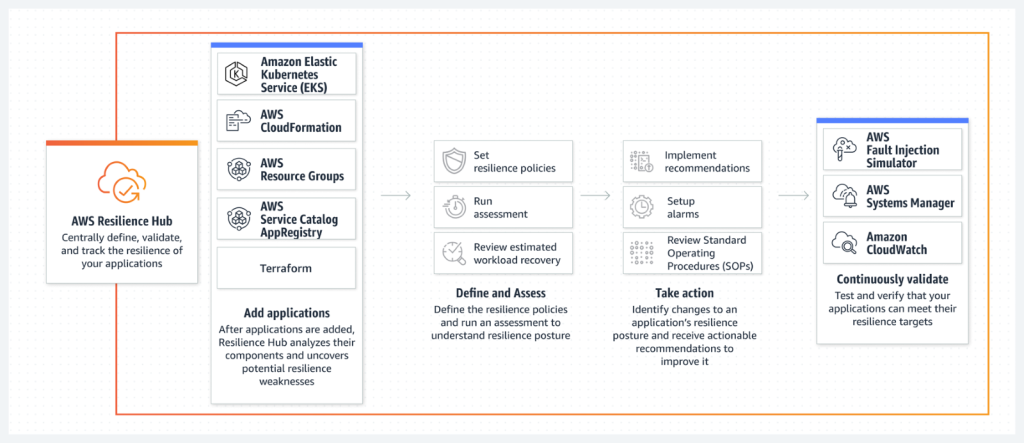Understanding AWS Resilience Hub – A Comprehensive Guide
In the ever-changing realm of cloud computing, the resilience of your applications and infrastructure is of utmost importance. AWS Resilience Hub, a robust offering from Amazon Web Services (AWS), empowers organizations to first define and then validate and track the resiliency of applications on the AWS cloud.
This comprehensive guide looks at AWS Resilience Hub, addressing its fundamental concepts and the optimal utilization of its features to strengthen the resilience of your AWS environment.
What is AWS Resilience Hub?
AWS Resilience Hub is a centralized platform that enables the management and monitoring of the resilience of AWS resources across multiple AWS accounts and regions. Owing to the use of this platform, organizations can centrally handle the backup and restore operations. This centralized location enhances operational efficiency and simplifies the administration of backup processes, providing enterprises with greater control and visibility over their disaster recovery strategies. The Resilience Hub brings a consolidated view of resource health and status, facilitating proactive issue detection and response.

Source: https://aws.amazon.com/resilience-hub/
Ensuring Application Resilience
The AWS Resilience Hub offers a range of key features that enhance application resilience and ensure smooth operations. It allows users to depict applications as collections of resources or Amazon EKS clusters for Kubernetes workloads. Additionally, application resilience policies can be defined, including recovery time objectives (RTO) and recovery point objectives (RPO) for various disruptions such as infrastructure, availability zone (AZ), and region failures. The Resilience Hub helps assess application component resilience by utilizing the Well-Architected Framework. Moreover, application resilience can be validated through pre-production testing using the AWS Fault Injection Simulator (FIS), which simulates real-world failures and integrates seamlessly with CI/CD pipelines.
The Resilience Hub also enables tracking of improvements in application resilience over time. It aggregates events, alerts, and insights, and generates a resilience score to provide clear visibility into application’s resilience status.
Importance of resilience in cloud computing
Resilience plays a critical role in cloud computing, ensuring the continuity and availability of services and applications even in the face of failures, disruptions, or unforeseen events. Unlike traditional data centers or hardware setups that are vulnerable to outages, hardware failures, or natural disasters, the cloud offers elasticity and scalable features that enable the construction of resilient architectures. These architectures allow for seamless failover, rapid recovery, and efficient scaling, resulting in uninterrupted service delivery, minimal downtime, and excellent user experience. Additionally, resilience in cloud computing is vital for meeting service level agreements (SLAs), building customer trust, and safeguarding critical data and business operations. By prioritizing resilience, organizations can establish robust and reliable cloud environments capable of adapting to change and effectively responding to challenges.
Building Resilient Architectures, Monitoring & Management
Building resilient architectures using AWS Resilience Hub involves incorporating key design principles such as redundancy, automation, monitoring and metrics, and elasticity. Resources should be distributed across multiple availability zones or regions for high availability. Automation, through tools like AWS Lambda, helps detect and respond to failures promptly. Robust monitoring and metrics using Resilience Hub and Amazon CloudWatch ensure the health and status of resources. Elasticity is achieved through auto-scaling and AWS Elastic Load Balancer. Resource groups and policies aid in managing and controlling resource resilience, enabling a unified view and consistent settings.
Monitoring and management are critical, with Resilience Hub offering centralized monitoring, alarms, and notifications for proactive resource health tracking. Alarms based on CloudWatch metrics trigger notifications or automated actions, enabling quick response and issue resolution.
Implementing High Availability & Disaster Recovery
AWS Resilience Hub acts as a unified platform for assessing and developing the resilience of AWS deployments, focusing on high availability (HA) and Disaster Recovery (DR) strategies. The hub enables organizations to assess their existing architectures to identify vulnerabilities and conduct risk analysis to prioritize resilience efforts. With the resilience hub, companies can simulate failure scenarios, automate recovery processes, and implement monitoring and alerting mechanisms. By leveraging these capabilities, organizations can strengthen the resilience of their AWS deployments, improve system availability, and enhance their ability to recover from disasters.
Benefits of Implementing High Availability (HA) & Disaster Recovery (DR) using AWS
Resilience implementing HA and DR using AWS Resilience Hub enables significant benefits for organizations. By providing a centralized management point, Resilience Hub simplifies the setup and configuration of HA and DR across multiple AWS accounts and regions. Automated failover processes enhance application availability, reducing manual intervention and minimizing downtime.
With the ability to set up DR configurations across regions, businesses can ensure continuity even in the face of regional outages or disasters. Resilience Hub also offers visibility and monitoring capabilities, allowing organizations to proactively detect and respond to issues. Simplified testing and validation processes streamline the assessment of HA and DR mechanisms, while the scalability and flexibility of Resilience Hub support evolving application requirements. Ultimately, implementing HA and DR using AWS Resilience Hub improves resilience, minimizes downtime, and ensures business continuity for critical applications and data.
How Noventiq Can Help with Resilience & Disaster Recovery
We, as an AWS Premier Consulting Partner plays a crucial role in helping clients achieve resilience and disaster recovery and derive several benefits such as better operational efficiency and minimized costs. By leveraging our expertise, clients can establish an efficient and fast disaster recovery framework, resulting in a reduction in the total cost of ownership (TCO). Additionally, the partner ensures that the Disaster Recovery (DR) environment adheres to global audit and compliance requirements, guaranteeing regulatory compliance across the board.
To Sum up
By understanding and effectively leveraging AWS Resilience Hub, businesses can ensure high resilience of their AWS environments, minimize downtime, and uninterrupted service delivery for their customers. Start the journey towards building highly resilient architecture using AWS Resilience Hub today






